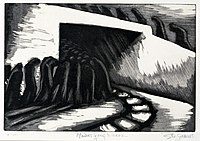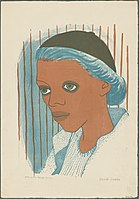Blanche Grambs | |
|---|---|
 Grambs at her drafting table working on a pastel drawing. Photographed for the Works Progress Administration. From the collection of the Archives of American Art. | |
| Born | Blanche Mary Grambs 1916 Beijing, China |
| Died | 2010 (aged 93–94) New York City |
| Nationality | American |
| Education | Art Students League |
| Known for | Painting, printmaking |
| Notable work | Miners[1] Miners Going to Work[2] |
Blanche Grambs (1916–2010) was an American artist who is known for her prints depicting the Great Depression, coal miners, the poor, and the unemployed.[3]
Life
[edit]She was born in Beijing, China.[4] She trained at the Art Students League in New York under Harry Sternberg. She worked in the Works Progress Administration's Federal Art Project during the New Deal, beginning in 1936 and producing over 30 prints for the WPA. She created lithographs and intaglio prints.[4]
Grambs was actively political, attending classes in Marxist theory at the New York Workers School and participating in communist rallies. She was arrested in 1936 at an organized sit-in, protesting cuts to the WPA FAP budget. For her art, she traveled to Lanceford, Pennsylvania to create prints and etchings of the coal miners. Grambs' work reflected her political leanings and commitment to social reform.[5]
She married Hugh "Lefty" Miller, and they moved to Paris together. Shortly after their arrival, war broke out, and they moved back to New York, where she continued to work as an artist. Her later work included contributing illustrations to over 30 children's books.[5]
Grambs' work is held in the Metropolitan Museum of Art,[6] the Philadelphia Museum of Art, the Detroit Institute of Art,[7] the Crystal Bridges Museum of American Art,[8] the Art Institute of Chicago,[9] the Baltimore Museum of Art,[10] the British Museum,[11] the Smithsonian American Art Museum,[12] and the University of Michigan Museum of Art.[13]
Gallery
[edit]-
Miners Going to Work, n.d
-
Girl With Blue Hair
-
Workers Homes, ca. 1935-1940
-
Mood, n.d
References
[edit]- ^ "Miners by Blanche Grambs / American Art". Retrieved 2011-12-17.
- ^ "Miners Going to Work by Blanche Grambs / American Art". Retrieved 2011-12-17.
- ^ "Blanche Grambs". IFPDA. Archived from the original on 2012-04-28. Retrieved 2011-12-17.
- ^ a b Heller, Jules; Heller, Nancy G. (2013-12-19). North American Women Artists of the Twentieth Century: A Biographical Dictionary. Routledge. ISBN 978-1-135-63889-4.
- ^ a b "Blanche Grambs | Information". British Museum. Retrieved 28 September 2022.
- ^ "Blanche Grambs". Metropolitan Museum of Art. Retrieved 28 September 2022.
- ^ "Jo". www.dia.org. Retrieved 2020-12-22.
- ^ "Works – Blanche Grambs – Artists – Crystal Bridges Museum of American Art". Retrieved 2020-12-22.
- ^ "Blanche Mary Grambs". The Art Institute of Chicago. Retrieved 2020-12-22.
- ^ "The Baltimore Museum of Art".
- ^ "Blanche Grambs". British Museum. Retrieved 28 September 2022.
- ^ "Blanche Grambs | Smithsonian American Art Museum". americanart.si.edu. Retrieved 2020-12-22.
- ^ "Exchange|Search: artist:"Blanche Grambs"". exchange.umma.umich.edu. Retrieved 2020-12-22.
External links
[edit]![]() Media related to Blanche Grambs at Wikimedia Commons
Media related to Blanche Grambs at Wikimedia Commons
![]() This article incorporates public domain material from websites or documents of the Works Progress Administration.
This article incorporates public domain material from websites or documents of the Works Progress Administration.



